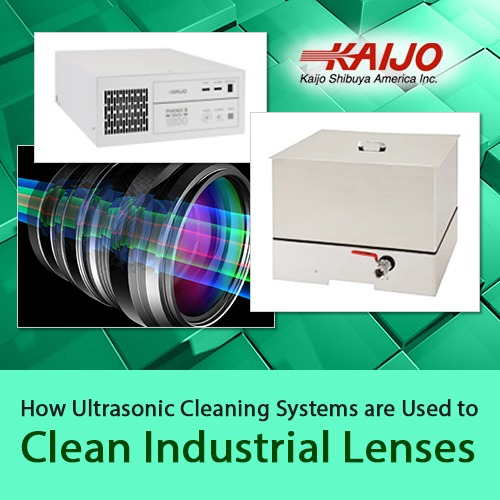Using Ultrasonic Cleaning Systems for Cleaning Industrial Lenses
May 29, 2018
 Ultrasonic cleaning systems can clean hard surfaces such as glass lenses quickly and effectively, but if there are any special characteristics of the lenses, choosing the correct ultrasonic frequency, power and bath can be important. Low frequencies may wear away or pit surfaces and hot baths or baths with detergents may dissolve or etch even hard materials. Glass itself is usually not affected by ultrasonic cleaning but special coatings, surface treatments or plastic lenses may be damaged. When there is any doubt, it’s important to get the right ultrasonic cleaning system and use the appropriate frequency and power settings for your specific application.
Ultrasonic cleaning systems can clean hard surfaces such as glass lenses quickly and effectively, but if there are any special characteristics of the lenses, choosing the correct ultrasonic frequency, power and bath can be important. Low frequencies may wear away or pit surfaces and hot baths or baths with detergents may dissolve or etch even hard materials. Glass itself is usually not affected by ultrasonic cleaning but special coatings, surface treatments or plastic lenses may be damaged. When there is any doubt, it’s important to get the right ultrasonic cleaning system and use the appropriate frequency and power settings for your specific application.
How Ultrasonic Frequencies Can Clean Lenses
Industrial lenses made only of pure glass are ideal candidates for ultrasonic cleaning. An ultrasonic generator produces the high-frequency electronic signal and a transducer immersed in the ultrasonic bath converts the signal to ultrasonic waves in the liquid. The waves create cavitation bubbles in the pressure troughs of the ultrasonic waves and the bubbles collapse again in the wave pressure peaks. This creation and collapse of microscopic bubbles in time with the ultrasonic frequency produces a powerful scrubbing action against the hard surfaces of the lenses. Anything adhering to the glass is removed.
Lower frequencies produce larger bubbles and a robust cleaning action while high frequencies produce smaller bubbles for more delicate cleaning. The power of the ultrasonic cleaning system impacts the amount of time required for cleaning as well. For some contaminants, such as grease and oily residue, a mild detergent helps the cleaning action as does heating the bath to soften such deposits.
Robust cleaning with the addition of detergents and heat cleans pure glass quickly and completely but when the lens has a treated surface or surface film, these measures may cause damage. A more careful, customized approach is required.
Gentle Cleaning of Delicate Lenses
Measures to safely use ultrasonic cleaning systems on all kinds of industrial lenses start with choosing a system that will clean gently while minimizing the time the lens stays immersed in the cleaning solution. The required ultrasonic frequency has to be high enough to avoid damaging coatings that are softer than pure glass. At the same time, many lens coatings are sensitive to lengthy immersion in water, possibly absorbing water, changing color or detaching from the lens surface. The frequency therefore has to be low enough to clean effectively, rapidly removing the particular kind of contaminant that is present.
While the chosen ultrasonic frequency determines the intensity of the cleaning action, the power of the system influences how quickly cleaning takes place. If the power is too low, too few bubbles are generated and the cleaning process takes longer. Exactly the right power level produces the maximum number of bubbles and the fastest cleaning. Even higher levels of power are wasted and don’t influence the cleaning speed.
Heat and detergents are sometimes incompatible with delicate surface treatments of lenses. If the ultrasonic cleaning system is properly configured for maximum cleaning speed, it is often not necessary to add detergents to the cleaning bath or apply heat. The trade-off between duration of the cleaning process and the addition of detergents or heat can be based on the specific lens treatment that has to undergo cleaning. If the coating is very sensitive to exposure in water, heat and a specially formulated solvent may speed up the process and reduce water exposure. In general, cleaning at room temperature using deionized water is the least aggressive and default solution.
Kaijo Offers Ultrasonic Cleaning System Consulting
Custom ultrasonic cleaning solutions are often the most effective and least damaging when delicate surfaces such as those of non-reflective industrial lenses have to be cleaned. Kaijo can suggest the best ultrasonic systems for specific industrial lens cleaning applications based on the company’s extensive experience in the ultrasonic cleaner field. In addition to finding effective solutions for such cleaning tasks, Kaijo can supply components or systems from its complete line of ultrasonic equipment.





